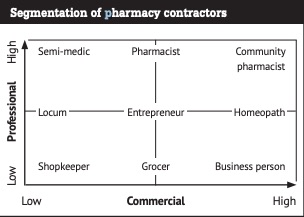Nine faces of pharmacy
In Views
Follow this topic
Bookmark
Record learning outcomes
 By Terry Maguire
By Terry Maguire
Like world peace and reducing carbon emissions, transformation of the pharmacy network seems logical and desirable, and in the interests of all. Or at least it seems logical and desirable to government. There are concerted moves to obtain added value from the pharmacy networks in each of the four UK jurisdictions with, seemingly, good support from pharmacy bodies.
Pharmacy bodies, of course, realise the threat posed by robotics and other technologies to the medicines supply chain, and that ‘Amazonisation’ presents a significant threat to networks and current provision. But what seems like a good idea at a higher level can seem less beneficial when the day to day detail is considered. For pharmacy, this includes practice and how we get paid.
Ultimately, the pharmacy network must be plugged into, and aligned with, the direction of travel of national healthcare policy. That policy is firmly towards the transformation of health services to become more patient and community focused, with a greater emphasis on primary and secondary disease prevention. Ironically, while pharmacists and pharmacy organisations publicly attest to a desire to transform by adopting more patient-centred services, when opportunities do exist, it is often pharmacists who are the most resistant.
Values and beliefs underpin individual attitudes and, ultimately, our attitudes determine our behaviour – what we do, rather than what we say we do. This is the human condition. Pharmacists are not a homogenous group, yet little attention has been given to the differences between members of the profession.
A thought experiment
Marketers use segmentation to better understand types within groups. As a thought experiment, I created pharmacist ‘types’ using two continuums: professionalism and commercialism (see figure). The segments are generalised, and I have tried to be descriptive rather than pejorative in the nomenclature.
 The ‘shopkeeper’ is low on both professionalism and commercialism. They will obey the law and stick to a code of ethics, but will seldom act, truly, in the best interests of the patient. We must be able to stand by our actions when asked to account for them by the courts or the regulatory body. Of course, the culture in the regulatory body says a lot about how pharmacy is practised. But pharmacists need to be acting and practising more in the interest of their patients if new professional norms are to be achieved.
The ‘shopkeeper’ is low on both professionalism and commercialism. They will obey the law and stick to a code of ethics, but will seldom act, truly, in the best interests of the patient. We must be able to stand by our actions when asked to account for them by the courts or the regulatory body. Of course, the culture in the regulatory body says a lot about how pharmacy is practised. But pharmacists need to be acting and practising more in the interest of their patients if new professional norms are to be achieved.
the ‘community pharmacist’, who represents the ideal mix of high commercialism and high professionalism
The ‘grocer’ keeps a tidier shop – a little more commercial – while the ‘business person’ has aspirations to be a multiple owner if they are not already. The business person is unwilling to risk their current commercial position for a change agenda that is uncertain. We really need to understand that.
The ‘locum’ is reasonably professional, but has no need for a genuinely commercial radar, while the ‘entrepreneur’ is sitting on the fence. They could be more professional or more commercial, depending on what motivates them at the time.
The ‘homeopath’ is high on commercialism, but lower on professionalism. They are often the adopters of new practice, but they can tip this over into pseudoscience if it’s to their commercial advantage. Think homeopathy, herbal remedies, CBD oil, Botox and other dubious new age trends.
The ‘semi-medics’ consider the patient first – they are often the ones who adopt new services more easily and they generally support change. They fail, however, to ensure that sufficient funding is retained to allow businesses to be sustainable.
The hero of this matrix is the ‘community pharmacist’, who represents the ideal mix of high commercialism and high professionalism.
If these pharmacist types, or ones like them, were to be verified, they could tell us a lot about why, as pharmacists, we act the way we do.
I have not done the fieldwork and therefore don’t know how many of each type we have in the contractor base. But I’d predict that most are ‘shopkeepers’. If that’s the case, then to awaken them, we need to engage both professionally and commercially, and align to national health policy along both axes.
There is a possibility to bring about the transformation we all seem to desire, but this will require a vision, strong leadership and a good understanding of ourselves.
